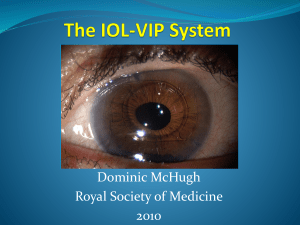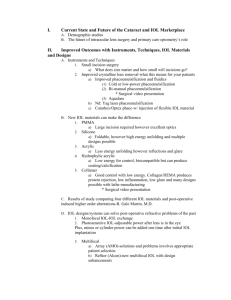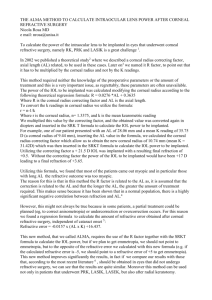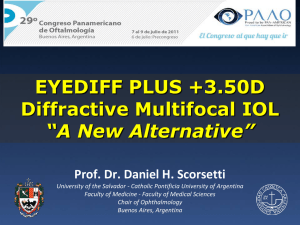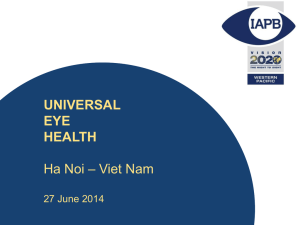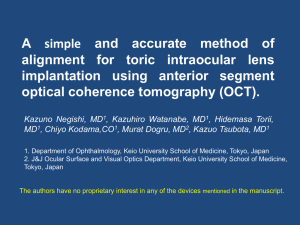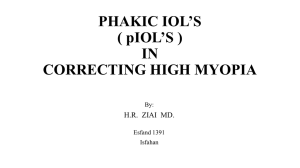Clinical Pearls for Optimizing CustomVue™ Outcomes
advertisement
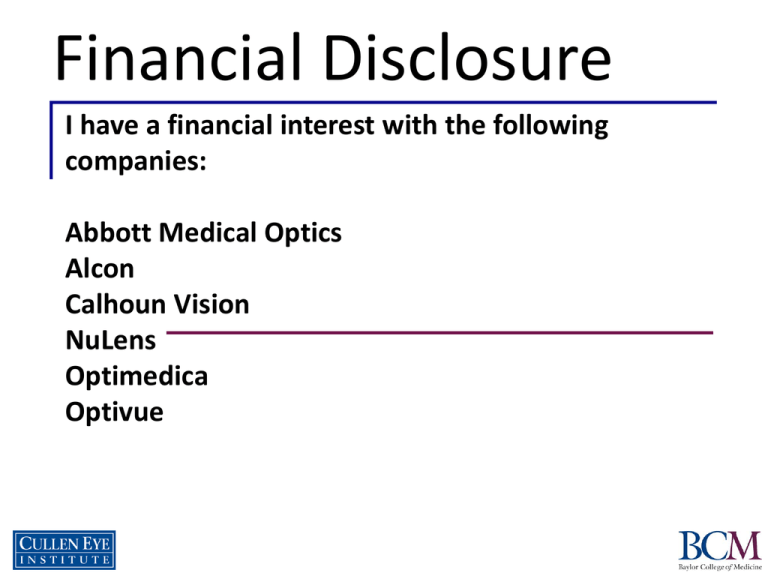
Financial Disclosure I have a financial interest with the following companies: Abbott Medical Optics Alcon Calhoun Vision NuLens Optimedica Optivue IOL power calculations in post-LASIK/PRK eyes Douglas D. Koch, M.D. Cullen Eye Institute, Baylor College of Medicine, Houston, TX Challenges Difficulties in determining true corneal refractive power Keratometric inaccuracy Invalid use of effective refractive index of cornea (1.3375) Problems in 3rd and 4th generation IOL formulas Inaccurate estimation of ELP Exception: Haigis formula So many formulas. . So we developed: http://www.ascrs.org/ IOL power calculation Prior myopic-LASIK/PRK Double-K Holladay 1 and Haigis-L formulas 3 categories of formulas 3 categories Traditionally “Gold” standard KEY – accurate historical data Data error 1:1 ratio Use a fraction of ∆MR Data error ↓ to 20 – 30% Rely only on current data Pop-up windows explain methods used Prior hyperopicLASIK/PRK Prior RK Monthly visits to the calculator in 2010 9,000 8,000 7,000 8,249 7,853 7,218 6,173 6,570 7,666 6,758 6,825 6,369 6,791 7,257 7,105 6,000 5,000 4,000 3,000 2,000 1,000 0 Jan Feb Mar Apr May Jun Jul Aug Sep Oct Nov Dec Patients 2 study centers Consecutive cases of IOL implantation in eyes with prior myopic-LASIK SN60WF 72 eyes of 57 patients included Mean age: 58 ± 8 years (range 42 to 77 years) Myopic LASIK correction: 5.10 ± 2.55 D (range 0.98 to 11.21 D) Methods IOL prediction error = IOL implanted – IOL calculated Negative value myopic results Consistency of prediction performance F-test for variances A -2.0 Average IOL power A Haigis-L Shammas 2.0 Wang-Koch-Maloney A Modified-Masket A Masket Adjusted Atlas0-3 A A Adjusted EffRP 4.0 Corneal Bypass -4.0 Feiz-Mannis Clinical History S A A A A A 0.0 A A AA A A Variances of IOL prediction errors (SD2) - consistency of performance * Pre-LASIK Ks + ∆ MR Clinical History Feiz-Mannis Corneal Bypass 2.06 2.53 1.99 ∆ MR Adjusted EffRP Adjusted Atlas0-3 Masket Modified-Masket 0.70 0.68 0.63 0.62 No prior data Wang-Koch-Maloney 0.68 Shammas 0.66 Haigis-L 0.66 * Significant differences (all P<0.05 with Bonferroni correction) Refractive prediction error ± 0.5 D ± 1.0 D Pre-LASIK Ks + ∆MR* Clinical History Feiz-Mannis Corneal Bypass 44 37 37 69 60 68 ∆MR Adjusted EffRP Adjusted Atlas0-3 Masket Modified-Masket 62 64 57 67 86 90 91 90 Methods Proposed UK NHS benchmark in normal eyes*: 85% ±1.0 D 55% ±0.5 D Met benchmark in normal eyes but well below latest standards No prior data Wang-Koch-Maloney 58 96 Shammas 60 90 Haigis-L 60 methods 94(P<0.05). Gale RP, et al. *Significant lower % with historical Benchmark standards for refractive outcomes after NHS cataract surgery. Eye. 2009;23:149-52 Summary Using double-K Holladay 1 formula Greater prediction errors and variances with methods requiring Pre-LASIK Ks and ∆MR Use 100% of historical data Superior and essentially equivalent results with: Methods using a fraction of ∆MR and Methods using no prior data Optical coherence tomography (OCT) RTVue-CAM: an Fourier domain OCT system for both retinal and corneal imaging RTVue with CAM module Net Corneal Power (NCP): Combines anterior & posterior curvature measurements from OCT meridional scans 1.5mm 1.5mm n0 = 1 D n1 = 1.376 Ra Rp n2 = 1.336 Kp n2 n1 Rp Ka n1 n0 Ra Evaluation of OCT-based formula IOL power calculation in post-LASIK eyes 12 eyes at Cullen Eye Institute 8 eyes at Doheny Eye Institute Refractive correction: -4.04 ± 3.60 D (range -0.88 to -9.81 D) OCT-based IOL power formula ELP = 0.711 * (AL – ACD) – 0.25 * Pp + 0.623 * ALadj + pACD – 8.11 Where AL = axial eye length (mm) ACD = Anterior chamber depth (mm) Pp = posterior corneal power (D) ALadj = sqrt(AL) if AL < 24.4mm sqrt(AL+0.8*(AL-24.4)), if AL > 24.4mm pACD = personalized ACD (ACD-constant) *Tang M, Li Y, Huang D. An Intraocular Lens Power Calculation Formula Based on Optical Coherence Tomography: a Pilot Study. J Refract Surg. 2010;26(6):430-437 Refractive prediction error Keratometry Method Best IOL Formula Prediction Error (D) Range (D) MAE (D) Adjusted MAE (D) IOL-Master Haigis-L -0.23 ± 0.83 (-1.93, 1.30) 0.66 0.65* OCT OCTbased -0.01 ± 0.70 (-0.85, 1.79) 0.56 0.56* *P=0.65, n = 20 eyes of 15 subjects. Refractive prediction error Haigis-L OCT formula 8 Within 0.5D: •Haigis-L: 11/20 •OCT: 10/20 # of eyes 6 4 Within 1D: •Haigis-L: 15/20 •OCT: 19/20 2 0 Predicted – Actual Postoperative Refraction (D) Summary Limitation: Small numbers Performance of OCT-based IOL formula was not compared to many methods on the ASCRS calculator Further studies desirable Recent study Accuracy of Galilei in IOL power calculation in eyes with prior myopic LASIK/PRK Consecutive cases of IOL implantation between April 08 to Feb. 11 Patients 19 eyes of 16 patients had all historical data LASIK correction: 4.28 ± 2.61 D (range 0.88 to 8.50 D) Myopic Refractive MAE with all methods (n=19) 1.2 1.0 0.99 0.94 0.93 0.78 0.65 0.6 0.52 0.57 0.57 0.75 0.72 0.70 0.47 0.42 0.44 0.4 Galilei Significant greater MAE with methods using pre-LASIK Ks and ∆MR than those with (all P<0.05) TCP-5mm TCP-4mm TCP-3mm TCP-2mm Haigis-L Shammas Wang-Koch-Maloney Modified-Masket Masket Adjusted Atlas0-3 Adjusted EffRP Corneal Bypass 0.0 Feiz-Mannis 0.2 Clinical History MAE (D) 0.8 Refractive prediction error with all methods UK NHS (n=19) 100 89 90 79 74 68 74 74 74 58 68 58 58 53 55% ±0.5 D 53 47 50 42 32 32 32 32 32 26 30 21 20 Galilei TCP-5mm TCP-4mm TCP-3mm TCP-2mm Haigis-L Shammas Wang-Koch-Maloney Modified-Masket Masket Adjusted Atlas0-3 Adjusted EffRP Corneal Bypass Feiz-Mannis 10 0 85% ±1.0 D 63 Clinical History % of eyes 79 +/- 0.5 D +/- 1.0D 70 40 89 84 79 80 60 benchmark 95 Accuracy of IOL power calculation in eyes with prior RK Purpose Because RK eyes have variable front and back curvatures, IOL calcs are especially challenging To evaluate the accuracy of 4 devices for calculating corneal power for IOL calculations in RK eyes undergoing cataract surgery IOLMaster, EyeSys, Atlas, Galilei Patients Consecutive cases of IOL implantation between April 08 to February 11 27 eyes of 18 patients, age 47 to 79 years Refractive mean absolute error (MAE) with different devices 0.8 0.7 0.65 0.67 0.66 0.58 0.6 MAE (D) 0.5 0.4 0.3 0.2 0.1 0.0 EyeSys EffRP IOLMasterK Atlaszone0-3 TCPannuli1-4 Galilei TCPannuli1-4 tended to produce smallest MAE (all P>0.05). Refractive prediction error +/- 0.50 D 85 +/- 1.0 D 90 UK NHS benchmark 85 85 78 80 85% ±1.0 D 70 59 % of eyes 60 55% ±0.5 D 52 50 40 33 30 30 20 10 0 EyeSys EffRP IOLMaster K Atlaszone0-3 TCPannuli1-4 Proposed benchmark for normal eyes: Gale RP, et al. Benchmark standards for refractive outcomes after NHS cataract surgery. Eye. 2009;23:149-52. Galilei Needs further work to improve IOL calculations after LASIK Helpful in eyes that have undergone radial keratotomy Thank you for your attention
